Free writing
July 2, 2008
Image: Xu Bing from “A Book from the Sky”
Free or ‘Asemic’ writing is writing with no direct semantic content, its meaning is implied and hinted at through abstraction. Meaning can be deduced by intuition and instinct – a natural understanding of shape or in shamanic religious work, through a power held in the design (usually transmitted through the artists from an external, mystical source). Asemic writing is art without rules; a form defined completely by the creator. The writer’s method can be a formal process – Xu Bing’s 4000 studiously detailed hand crafted characters – or divined through a trance or drug induced state – Gedewon‘s talismanic healing drawings, Michaux’s mescalin drawings – or ‘Psychography’ a personal cryptomnesiac script (echoes of ‘automatic writing’ of spiritualist mediums or Gysin/Borroughs ‘cut ups’ – a technique intended to reveal hidden meaning within a text by random and ‘magical’ association).
Image: Xu Bing “New English Calligraphy” 1998
Xu Bing is a Chinese artist who’s work is centered around meaning, confusion and confrontation. “A Book From The Sky” (1988) was written using his own hand crafted and invented ‘Chinese’ characters. What appears to be a lyrical work of Chinese calligraphy is actually ‘unintelligible’ and ‘meaningless’ ( In the Chinese language making something look ‘Chinese’ and at the same time be meaningless has an extra layer of complexity; meaning and phonetic are defined by two ideograms which influence each other rather than a single letter in western alphabets).
image: Henri Michaux ‘Narration’ (1927)
The dynamic graphic quality of oriental calligraphy combined with it’s dissociation from meaning (from a western point of view) has had a powerful influence of Asemic artists; The surrealist Belgian poet and painter Henri Michaux (1899-1984) betrays an orientalist influence in his automatic drawings – abstract calligraphic pieces in black ink; “a new language, spurning the verbal” begun after his travels in China and Japan:
” The destiny that awaited Chinese was utter weightlessness.
The characters that evolved were better suited than their archaic predecessors in terms of speed, agility, deftness of gesture. A certain kind of Chinese landscape painting demands speed, can only be executed with the same sudden release as the paw of a springing tiger. (For which one must first be concentrated, self-contained and, at the same time, relaxed).
The calligrapher, likewise, must first be plunged in meditation, be charged with energy in order to release: to discharge that very energy. And all at once.”
During the 1950s Michaux experimented with writing and drawing under the influence of the psychedelic drug mescaline. These experiments resulted in a series of alchemic drawings and abstract poems and made Michaux a champion of the Beats – Kerouak, Gysin etc – yet Michaux’s use of the drug was more shamanistic; by removing himself from conscious influence and by emptying his mind ( Michaux; “monastery of the mind”) Michaux used the drug as a tool to explore a pre-cultural commonality underlying language and poetry:
“Sometimes words would be fused together on the spot. For example, “Martyrissibly” would recur to me time and time again, speaking volumes. I couldn’t get rid of it. Another repeated untiringly, “Krakatoa !” “Krakatoa !” or sometimes a quite ordinary word like “crystal” would return twenty times in succession, giving me a great harangue all by itself, out of another world, and I could never have augmented it in the least or supplemented it with some other word. Alone, like a castaway on an island, it was everything to me, and the restless ocean out of which it had just come and of which it irresistibly reminded me, for I too was shipwrecked and alone end holding out against disaster.”
image: Henri Michaux ‘Mescaline Drawing’ (1956)
Fellow Belgian artist and poet Christian Dotremont, (1922 -1979) followed a similar trajectory to Michaux, originally part of the Belgian Surrealists he became, with Asger Jorn, a founder of the COBRA group in 1948. Dotremont betrays a strong orientalist (‘a romanticised interpretation of asian culture’) influence in his ‘Logograms’ abstract calligraphic drawings based on an imaginary script.
Gedewon, (1939, Bagemdir, Ethiopia – 1995, Därtähal, Ethiopia) a poet, cleric and mystic of the Ethiopian Orthodox Church was also initiated into the practice of healing talismanic art. Ethiopian talismanic art traces it’s roots back to fourth century Gnostic christianity with influences from Kabbala and Arabic alchemy. Gedewon’s work in the shamanic tradition was intended to heal the patient by exorcising demonic spirits causing ill health; bad spirits within the patient view the talisman through the patients eyes and are drawn out by the maze-like drawings eventually becoming trapped and destroyed within the complex mix of patterns and words. The drawings comprise of geometric, hallucinatory abstract designs undulating around an unidentifiable language and numerological script.
—
Sources:
Henri Michaux
-
- http://www.lycaeum.org/books/books/miserablemiracle/chap3.html
- Henri Michaux “ideograms in China” New Directions 2002 ISBN:0811214907
Christian Dotremont:

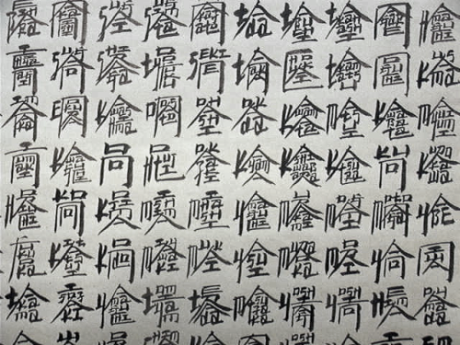
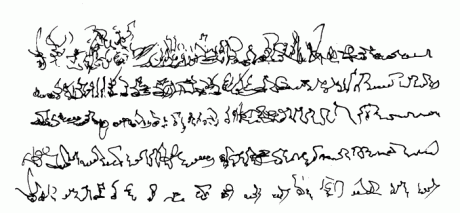

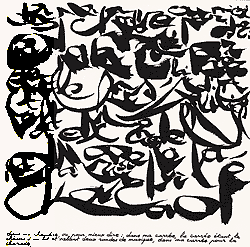
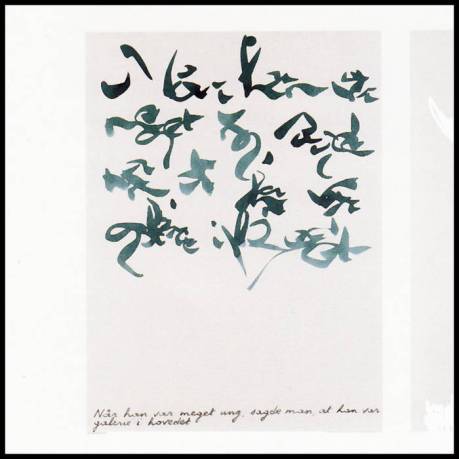
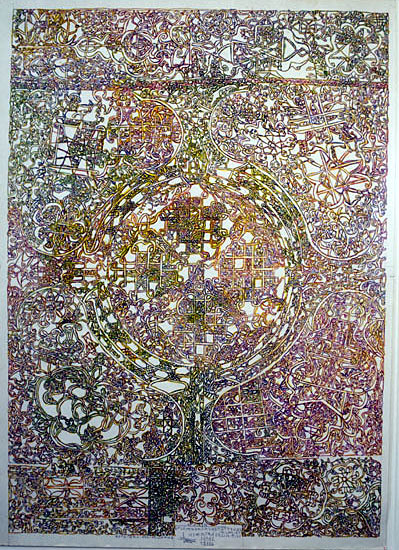
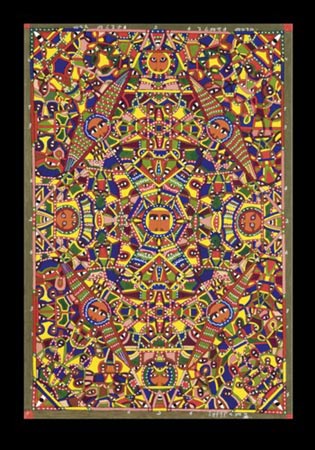
Gysin:
Actually, I was looking for an image of one of his huge calligraphic desert paintings but couldn’t find a good one.
oh… no images allowed in the comments? OK:
http://tinyurl.com/5f6cws
http://tinyurl.com/685gjc
http://tinyurl.com/5qj22c
Michaux’s mescaline drawings look to me to be acoustic spectrograms sometimes (Douglas Kahn has a perceptive take on this). I like the model of the ‘artist as a receiver’, rather than the agent of production. Tim Knowles has done some interesting drawing-enabler systems which take this a bit further. sort of natural science automatic writing:
http://www.timknowles.co.uk/Home/tabid/262/Default.aspx
i particularly like his tree drawings.
Beautiful stuff!
[…] the Codex Seraphinianus has been keeping tight-lipped for years besides reportedly indicating that asemic writing is involved.) Then there’s what happens when you involve that other kind of […]
sometimes desert faraway,
i have never seen her light
[…] some more on Asemic writing (and here). Like this:LikeBe the first to like this post. […]
Being a big fan of the Beats, particularly Burroughs, and also finding my way here via Wikipedia while reading about the Voynich Manuscript and the Codex Seraphinius, I stumbled across A Book From The Sky. It fascinated me, living as I do, here in Japan. Now you’ve turned me on to Michaux and Dotremont! Thank you for writing about such a fascinating topic! Sincerely, Pablo from Bang of Sun. :)
[…] Asemic writing has no verbal sense, though it may have clear textual sense. Through its formatting and structure, asemic writing may suggest a type of document and, thereby, suggest a meaning. The form of art is still writing, often calligraphic in form, and either depends on a reader’s sense and knowledge of writing systems for it to make sense, or can be understood through aesthetic intuition. http://www.intermediapoetry.com/2010/02/asemic-writing.html https://crab.wordpress.com/2008/07/02/free-writing/ […]
Lovely heavyweight post: ideas, meanings and embodiment exploding into space – thanks. Judiciously placed in Wikipedia for Xu Bing. Minor gripe: if you write to make sense – a kind of semantic tonality, and worth working for – some of the apostrophes are jarringly dissonant. “it’s” always = “it is”, not the possessive; “art traces it’s roots” should be “art traces its roots” …
[…] quick-hit exploration of asemic writing/art, including examples from Henri Michaux and Xu Bing, author of A Book from the […]
Thank’s for information – I’m an schoolart teacher.